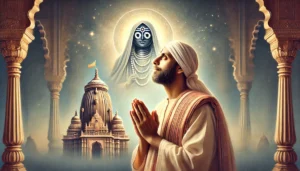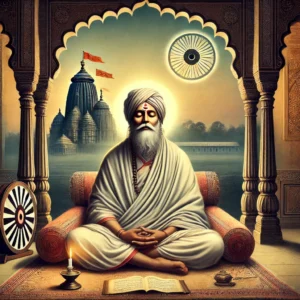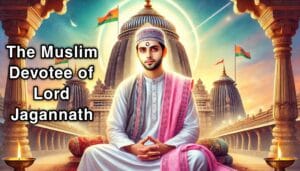
Muslim devotee of Lord Jagannath: Story of Salabega
Salabega: The Devout Muslim Poet Who Surrendered to Lord Jagannath
India’s spiritual heritage is replete with stories of devotion that transcend religious and societal boundaries. One such extraordinary tale is that of Salabega, a devout Muslim poet-saint who became one of the greatest devotees of Lord Jagannath. Despite being born into a Mughal family, his unwavering bhakti (devotion) towards the deity of Puri made him a revered figure in Odisha’s cultural and religious landscape. His bhajans (devotional hymns), filled with heartfelt longing and surrender, continue to inspire millions of devotees even today.
Birth and Early Life of Salabega
Salabega was born in the early 17th century to Jahiruddin Muhammad, a Mughal subedar (military officer) serving in Odisha, and a Hindu Brahmin widow whom Jahiruddin had taken as his wife. Raised in a predominantly Muslim environment, Salabega was initially unaware of Hindu traditions and religious beliefs. However, divine destiny had a different plan for him.
As a young man, Salabega followed in his father’s footsteps and participated in military expeditions. During one such campaign, he was grievously wounded in battle. When all medical treatments failed, his mother advised him to chant the name of Lord Jagannath. Miraculously, he recovered, and this incident became the turning point of his life. The young soldier experienced an inner awakening and developed an intense devotion towards Lord Jagannath, vowing to dedicate his life to the Supreme Lord of Puri.
Salabega’s Quest for Lord Jagannath
Determined to have darshan (sacred vision) of his beloved Lord, Salabega set out for Puri, the holy city where the majestic Jagannath Temple stands. However, being born a Muslim, he was denied entry into the temple, which was then strictly accessible only to Hindus. This rejection deeply saddened him, but his faith remained unshaken. Instead of turning away, he began expressing his love through poetry, composing soul-stirring bhajans in Odia that glorified the greatness of Lord Jagannath.
Salabega renounced worldly pleasures and became an ascetic, dedicating his entire life to singing praises of the Lord. He chose to live in seclusion, focusing solely on his spiritual union with Jagannath through bhakti and music.
Table of Contents

Muslim devotee of Lord Jagannath: Story of Salabega
The Miracle of the Rath Yatra
One of the most legendary stories about Salabega revolves around the Rath Yatra, the grand annual chariot festival of Lord Jagannath.
Once, while traveling to Puri to witness the Rath Yatra, Salabega fell severely ill and could not reach the city on time. Overwhelmed with sorrow, he prayed fervently to Lord Jagannath, pleading for a chance to see Him. Moved by his devotion and sincerity, it is believed that Lord Jagannath miraculously halted His chariot at Balagandi on the Grand Road (Bada Danda) and refused to move forward. The chariot remained stuck despite all efforts from priests and devotees to pull it forward.
When Salabega finally arrived and had a glimpse (darshan) of his beloved Lord, the chariot resumed its journey as if responding to the call of His true devotee. This divine incident became a symbol of Lord Jagannath’s boundless love for His devotees, proving that bhakti (devotion) surpasses all barriers of religion, caste, or birth.
To this day, during every Rath Yatra, the chariot of Lord Jagannath pauses briefly near Salabega’s samadhi (tomb) on the Grand Road, as if honoring the devotion of this extraordinary poet-saint.
Salabega’s Bhajans: Echoes of Eternal Devotion
Salabega’s bhajans (devotional hymns) are considered timeless treasures of Odia literature and devotional music. Filled with deep emotions, these songs express:
- Longing for divine grace
- A devotee’s helplessness before the Lord’s will
- Unwavering faith in Lord Jagannath’s protection
- A deep yearning to be united with the Supreme
Some of his most famous bhajans include:
- “Ahe Nila Saila” – The Most Famous Hymn
One of Salabega’s most iconic compositions, this bhajan is a heartfelt plea to Lord Jagannath for protection. The song is filled with sorrow, devotion, and an unshakable faith in the Lord’s mercy. Even today, it is sung by devotees across Odisha, especially during Rath Yatra.
- “To Lagi Gopada” – The Song of Surrender
This bhajan beautifully conveys the complete surrender of a devotee to the divine feet of Lord Jagannath. It reflects the essence of bhakti yoga, where the devotee gives up all ego and relies solely on the Lord’s grace.
- “Nila Chhaya Tora” – The Hymn of Separation
This song is filled with viraha rasa (the pain of separation), where Salabega expresses the agony of being away from the Lord and prays for divine union.
Salabega’s bhajans are still widely sung in Odisha and have been passed down through generations. They remain a fundamental part of Jagannath culture, proving that devotion transcends all social and religious barriers.
The Final Years of Salabega
Towards the end of his life, Salabega chose to reside near Bada Danda in Puri, spending his days meditating, composing bhajans, and longing for Lord Jagannath. Even though he was never allowed inside the temple, his faith never wavered.
After his passing, his devotees built a samadhi (tomb) in his honor on the Grand Road, the very path taken by Lord Jagannath’s chariot during the Rath Yatra. To this day, devotees stop there to offer prayers, honoring the great saint-poet who showed that true bhakti is beyond religion.
Legacy of Salabega
Salabega’s life is a testament to the universal nature of devotion. His story continues to inspire people of all backgrounds, reminding us that:
- God does not discriminate based on religion or birth
- True devotion (bhakti) is the only path to divine grace
- Sincere prayers always reach the Lord, no matter where we are
- Music and poetry can be powerful expressions of spirituality
Even today, during the Rath Yatra, thousands of devotees pause at Salabega’s tomb to offer their respects. His bhajans remain a vital part of Jagannath worship, proving that his soulful connection with the Lord remains unbroken, even beyond death.

Muslim devotee of Lord Jagannath: Story of Salabega
Conclusion
The story of Salabega is not just about a Muslim devotee of Lord Jagannath—it is a story of universal love, devotion, and divine grace. His bhakti transcended religious boundaries, proving that the Lord belongs to all, regardless of their background. His compositions continue to resonate in the hearts of devotees, carrying forward the message of faith, surrender, and divine love.
In a world often divided by religion and caste, Salabega’s life serves as a shining example of how true devotion can break all barriers and unite humanity in love for the Divine.
FAQs on Salabega: The Muslim Devotee of Lord Jagannath
- Who was Salabega?
Salabega was a 17th-century poet and devout devotee of Lord Jagannath, known for his deeply emotional and devotional Odia bhajans.
- What was Salabega’s background?
He was born to a Mughal soldier named Jahangir Khan and a Hindu Brahmin woman. Despite his Islamic heritage, he embraced devotion to Lord Jagannath.
- How did Salabega become a devotee of Lord Jagannath?
After falling severely ill, he remembered his mother’s teachings and prayed to Lord Jagannath, experiencing a miraculous recovery. This deepened his faith in the deity.
- What is Salabega’s contribution to Odia literature?
Salabega composed numerous bhajans (devotional songs) dedicated to Lord Jagannath, expressing deep love, longing, and surrender. His poetry remains popular in Odisha.
- What is the significance of Salabega’s poems?
His bhajans are considered some of the most heartfelt expressions of Bhakti (devotion), emphasizing Lord Jagannath’s mercy and inclusivity.
- Is there any historical evidence of Salabega’s existence?
While historical records are scarce, his works and the traditions surrounding his devotion have been preserved in Odisha’s cultural and religious history.
- What is the legend of Salabega and the Rath Yatra?
It is believed that Salabega once wanted to witness the Rath Yatra but was unable to travel. Miraculously, Lord Jagannath’s chariot stopped until he arrived, showing divine grace.
- Where is Salabega’s samadhi (memorial)?
His samadhi is located on the Grand Road in Puri, near the Jagannath Temple, where devotees pay respects during the Rath Yatra.
- Why is Salabega revered despite being born into a Muslim family?
His unwavering devotion to Lord Jagannath transcended religious boundaries, making him a symbol of universal Bhakti and divine love.
- Are Salabega’s bhajans still sung today?
Yes, his bhajans are an integral part of Odisha’s spiritual and cultural life, often sung during Rath Yatra and other Jagannath-related festivals.
Summary
Salabega: The Devout Muslim Poet of Lord Jagannath
Salabega was a 17th-century poet and ardent devotee of Lord Jagannath, whose unwavering faith transcended religious barriers. Born to a Muslim father, the Mughal subedar Jalaluddin, and a Hindu mother, Salabega was exposed to both Islamic and Hindu traditions. However, his spiritual journey took a significant turn after a life-threatening illness, during which he was advised to chant the name of Lord Jagannath. Miraculously, he recovered, and this experience deepened his devotion to the deity of Puri.
A Life Dedicated to Devotion
Despite his Muslim lineage, Salabega became one of the most celebrated Odia poets of Bhakti literature. He composed numerous bhajans and hymns that express an intense yearning for Lord Jagannath, filled with deep emotional surrender. His works, primarily written in Odia, depict the Supreme Lord as a savior who transcends all social and religious divisions. His most famous composition, Ahe Nila Saila, remains one of the most revered hymns in Odia culture and is still sung during religious occasions, especially during the annual Rath Yatra.
The Rath Yatra Miracle
Since Salabega was not allowed to enter the Jagannath Temple due to his Muslim background, he longed to see his beloved Lord during the Rath Yatra. According to legend, when he was unable to reach Puri in time for the festival, he fervently prayed for a glimpse of Jagannath. Moved by his devotion, Lord Jagannath is believed to have miraculously stopped his chariot, the Nandighosa, near the place where Salabega was staying, allowing him to have darshan. This spot is now marked by Salabega’s Samadhi (memorial) near the Gundicha Temple, where devotees still pay homage to him.
Legacy of a Universal Devotee
Salabega’s life is a testament to the power of devotion that transcends religious and social boundaries. His works continue to inspire generations, promoting the message that divine love is beyond caste, creed, and birth. His poetic contributions enriched Odia literature and established him as one of the greatest Bhakti poets in Indian history. His devotion is celebrated annually during the Rath Yatra, as his hymns echo in the streets of Puri, reminding devotees of the boundless grace of Lord Jagannath.
Unlock the Ancient Wisdom of Sanatan Dharma – Join Us on YouTube!
👉 Subscribe now to Prachin Sanatan Dharma and embark on a journey of enlightenment.
Explore timeless teachings, spiritual insights, and cultural richness on our YouTube channel, Prachin Sanatan Dharma. Dive deep into the essence of Sanatan Dharma through captivating videos that inspire and educate.
Related Articles
- Restful Nights: Ayurvedic Remedies and Traditional Indian Practices to Overcome Insomnia and Late-Night Habits
- The Tridevi: Lakshmi, Saraswati, and Parvati – Their Roles and Powers
- “Divine Creatures of Ancient Indian Scriptures: Exploring the Role of Animals in the Vedas, Puranas, and Mahabharata”
- Nature and Spirituality: Exploring the Sacred Essence of the Himalayas, Ganga, and Other Natural Wonders”
- “Reviving the Gurukul System: Relevance and Lessons for Modern Education”
- “Exploring Greek and Indian Mythology: Similarities Between Greek and Indian Mythology “
- “Embracing Sattvic Living: Harmonizing Mind, Body, and Soul Through Food and Lifestyle”
- “Charity and Prosperity: Exploring the Concept of Daan and Its Financial Relevance in Modern Life”
- How to Build an Eco-Friendly Home Inspired by Vastu Shastra
- Comparison of Ancient and Modern Sports: How Traditional Sports Have Influenced Contemporary Games
- “Timeless Lessons from Ancient Tales: Linking Samudra Manthan and Ganga’s Descent to Modern Ecological Challenges”
- “Reviving Sanskrit: How AI is Preserving Ancient Languages for the Future”
- “Mathura: The Sacred Land of Lord Krishna’s Divine Leelas”
- Investing for Future Generations: Lessons from Indian Traditions on Legacy Building and Wealth Preservation
- “Ancient Indian Wisdom: Timeless Lessons for Tackling Today’s Climate Crisis”
- “Artificial Intelligence and Spirituality: Transforming Ancient Practices for the Modern World”
- “Gold and Real Estate in India: Timeless Assets Shaping Financial Strategies”
- Tradition Meets Innovation: The Evolution of Technology in Hindu Rituals
- End-of-World Myths: Exploring Kali Yuga in Hinduism and Ragnarök in Norse Mythology
- Garuda, Pegasus, and Dragons: The Universal Ties of Mythical Beasts Across Cultures
- “Ancient Vimanas: Mythical Flying Machines or Evidence of Advanced Technology?”
- Time Travel in Hindu Mythology: The Fascinating Tales of Kakudmi and King Raivata
- “Divine Feminine Power in Hindu Mythology: The Legends of Durga, Saraswati, and Lakshmi”
- “Divine Beings of Sanatan Dharma: The Spiritual Significance of Sacred Animals in Hinduism”
- “Symbolism in Mythological Art: Unlocking Hidden Meanings in Ancient Temple Carvings”
- “Exploring Technological Advancements in Ancient India and Civilizations: Vimana, Metallurgy, & Water Management systems”
- Unveiling the Mysteries: Ancient Temples of Sanatan Dharma , Mysterious Temples of India
- “The Scientific Knowledge of Sanatan Dharma: Ancient Wisdom Meets Modern Science”
- Ancient Indian Sports and Games: Celebrating a Legacy of Skill, Strength & Strategy”
- “Exploring the Cosmic Link: The Connection Between Astronomy and Vedic Astrology”
- The Power of Sanskrit: Unlocking the Divine Language of the Gods
- “The End of Kaliyuga: A Sanatan Insight into the World’s Final Chapter”
- Explore more articles on Prachin Sanatan Yuga.
Muslim devotee of Lord Jagannath: Story of Salabega Muslim devotee of Lord Jagannath: Story of Salabega Muslim devotee of Lord Jagannath: Story of Salabega Muslim devotee of Lord Jagannath: Story of Salabega Muslim devotee of Lord Jagannath: Story of Salabega Muslim devotee of Lord Jagannath: Story of Salabega Muslim devotee of Lord Jagannath: Story of Salabega Muslim devotee of Lord Jagannath: Story of Salabega
Muslim devotee of Lord Jagannath: Story of Salabega Muslim devotee of Lord Jagannath: Story of Salabega Muslim devotee of Lord Jagannath: Story of Salabega Muslim devotee of Lord Jagannath: Story of Salabega Muslim devotee of Lord Jagannath: Story of Salabega Muslim devotee of Lord Jagannath: Story of Salabega Muslim devotee of Lord Jagannath: Story of Salabega Muslim devotee of Lord Jagannath: Story of Salabega
Muslim devotee of Lord Jagannath: Story of Salabega Muslim devotee of Lord Jagannath: Story of Salabega Muslim devotee of Lord Jagannath: Story of Salabega Muslim devotee of Lord Jagannath: Story of Salabega Muslim devotee of Lord Jagannath: Story of Salabega Muslim devotee of Lord Jagannath: Story of Salabega Muslim devotee of Lord Jagannath: Story of Salabega Muslim devotee of Lord Jagannath: Story of Salabega
Muslim devotee of Lord Jagannath: Story of Salabega Muslim devotee of Lord Jagannath: Story of Salabega Muslim devotee of Lord Jagannath: Story of Salabega Muslim devotee of Lord Jagannath: Story of Salabega Muslim devotee of Lord Jagannath: Story of Salabega Muslim devotee of Lord Jagannath: Story of Salabega Muslim devotee of Lord Jagannath: Story of Salabega Muslim devotee of Lord Jagannath: Story of Salabega

jai jagannath
Jai jagannath